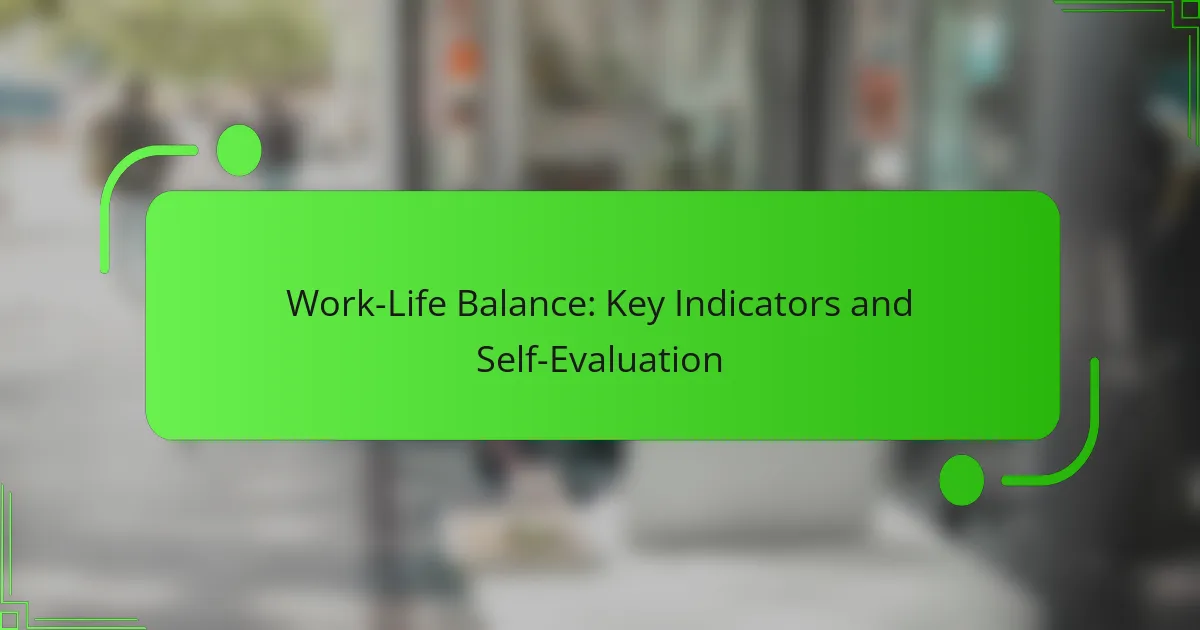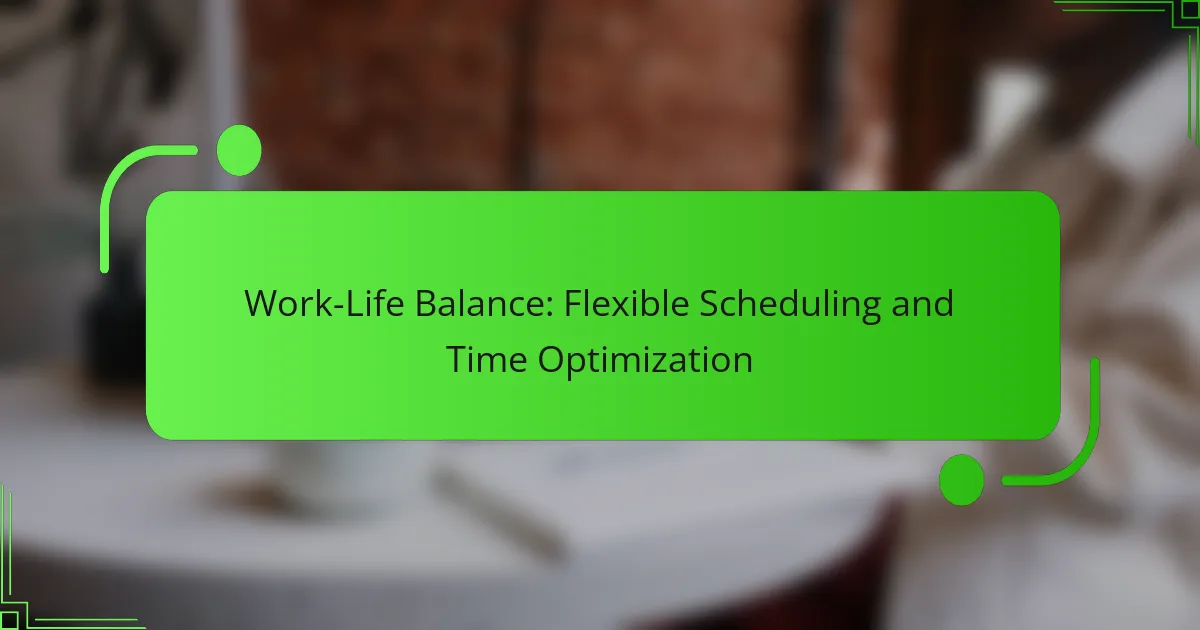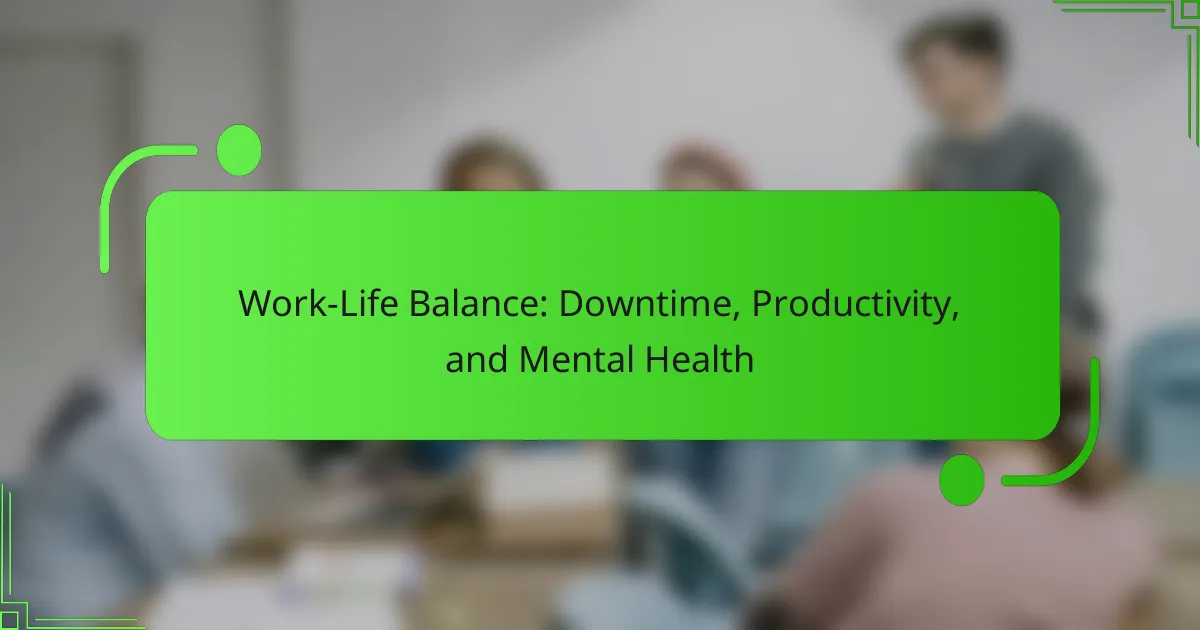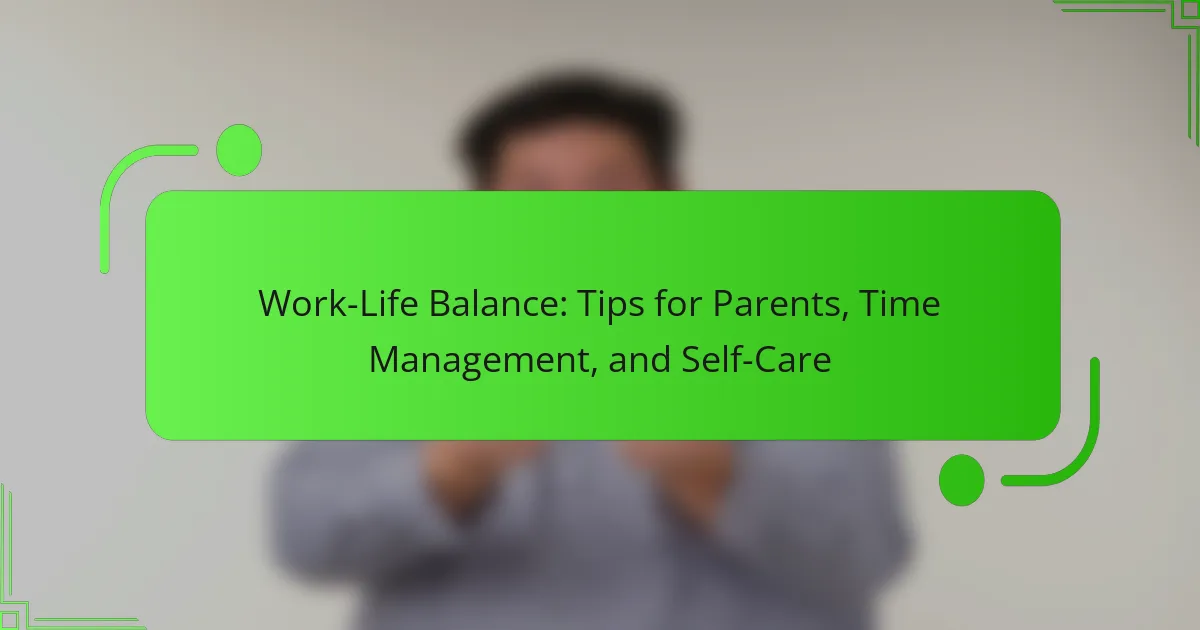Achieving a healthy work-life balance is essential for overall well-being and productivity, particularly in bustling urban environments. Key indicators such as job satisfaction, personal time allocation, and stress levels can help you assess how effectively you integrate your professional and personal lives. By engaging in self-evaluation and reflecting on your daily routines, you can identify areas for improvement and foster a more harmonious lifestyle.

How can I improve my work-life balance in major cities?
Improving work-life balance in major cities often involves adopting flexible work arrangements, effective time management, and personal well-being practices. By focusing on these areas, you can create a more harmonious integration of your professional and personal life.
Flexible work hours
Flexible work hours allow employees to adjust their schedules to better fit their personal needs. This can mean starting and ending work earlier or later, depending on individual preferences and responsibilities.
Consider discussing with your employer the possibility of a staggered schedule or compressed workweek. Many companies in urban areas are increasingly open to these arrangements, which can significantly enhance your work-life balance.
Remote work options
Remote work options enable you to perform your job from home or other locations, reducing commute time and increasing personal time. This flexibility can lead to higher productivity and lower stress levels.
When exploring remote work, assess your company’s policies and the tools available for effective communication and collaboration. Many organizations now offer hybrid models, allowing employees to work both in-office and remotely.
Time management techniques
Effective time management techniques can help you prioritize tasks and allocate time wisely. Methods such as the Pomodoro Technique or time blocking can enhance focus and efficiency.
Consider creating a daily or weekly planner to outline your tasks and deadlines. This can help you identify when to work and when to take breaks, ensuring a balanced approach to your responsibilities.
Mindfulness practices
Incorporating mindfulness practices into your routine can improve mental clarity and reduce stress. Techniques such as meditation, deep breathing, or yoga can help you stay grounded amidst a busy schedule.
Even short sessions of mindfulness, lasting just a few minutes, can be beneficial. Try setting aside time during your day to practice these techniques, whether at home or during breaks at work.
Setting boundaries
Setting clear boundaries between work and personal life is crucial for maintaining balance. This can involve defining specific work hours and communicating these to colleagues and family.
Be firm about your availability outside of work hours. Consider using tools like email auto-responders to indicate when you are not available, helping to establish a clear separation between professional and personal time.
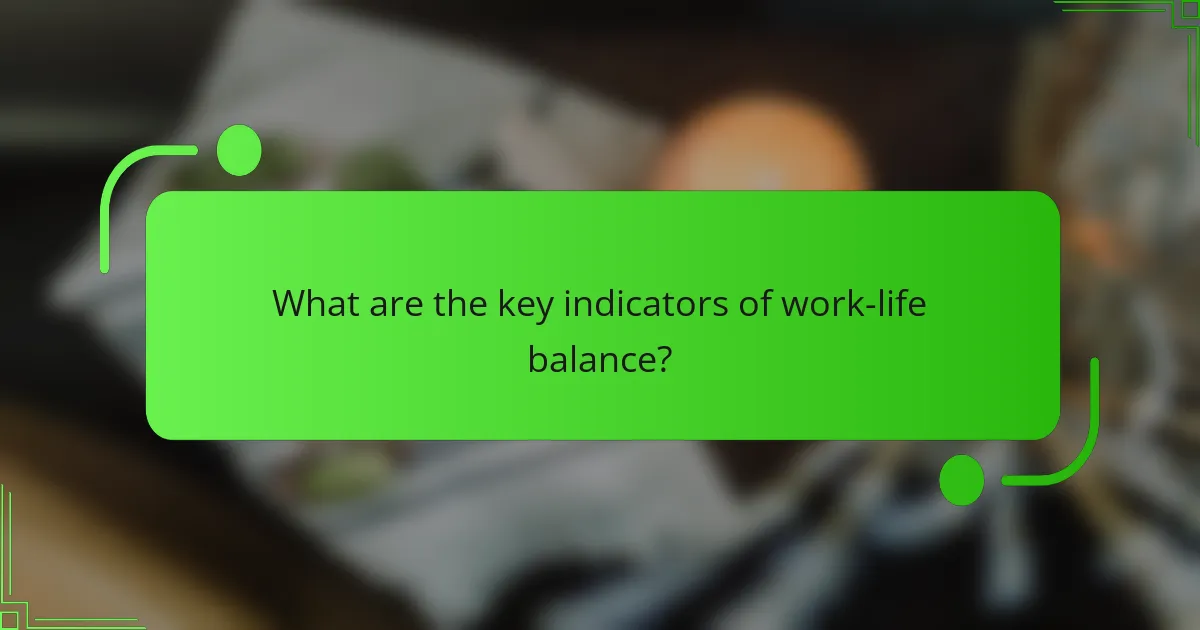
What are the key indicators of work-life balance?
The key indicators of work-life balance include job satisfaction levels, personal time allocation, stress levels, and work engagement. These factors collectively determine how effectively individuals manage their professional and personal lives, influencing overall well-being and productivity.
Job satisfaction levels
Job satisfaction is a critical indicator of work-life balance, reflecting how content individuals are with their roles. High satisfaction often correlates with a positive work environment, supportive management, and fulfilling tasks.
To assess job satisfaction, consider conducting regular surveys or self-reflections. Aim for a satisfaction level above 70% to indicate a healthy balance between work and personal life.
Personal time allocation
Personal time allocation measures how much time individuals dedicate to personal activities versus work responsibilities. A balanced allocation typically includes sufficient time for family, hobbies, and self-care.
As a guideline, aim for at least 20-30 hours of personal time per week. Keep track of your time to identify areas where work may be encroaching on personal life, and adjust accordingly.
Stress levels
Stress levels are a significant indicator of work-life balance, as high stress can lead to burnout and decreased productivity. Regularly evaluate your stress through self-assessments or stress management tools.
Consider implementing techniques such as mindfulness or time management strategies to reduce stress. If stress consistently exceeds manageable levels, it may be necessary to reassess work commitments or seek support.
Work engagement
Work engagement reflects how emotionally invested individuals are in their jobs. High engagement often indicates a strong connection to work, contributing positively to overall satisfaction and productivity.
To foster engagement, seek roles that align with personal values and strengths. Regularly set professional goals and seek feedback to maintain motivation and connection to your work.

How can I self-evaluate my work-life balance?
To self-evaluate your work-life balance, consider assessing how well you manage your professional responsibilities alongside personal time. This involves reflecting on your daily routines, stress levels, and overall satisfaction with both work and personal life.
Self-assessment questionnaires
Self-assessment questionnaires are tools designed to help you reflect on your work-life balance. These questionnaires typically include a series of questions about your time allocation, stress levels, and satisfaction in various life areas. You can find many free resources online that provide structured assessments, allowing you to identify areas needing improvement.
When using these questionnaires, be honest with your responses. Common pitfalls include underestimating work hours or overlooking personal time spent on leisure activities. Aim for a balanced score that indicates neither work nor personal life is excessively dominating your time.
Time tracking tools
Time tracking tools can help you visualize how you spend your hours throughout the day. By logging your activities, you can identify patterns that may reveal an imbalance between work and personal time. Popular tools include apps like Toggl or RescueTime, which provide insights into your productivity and time allocation.
To effectively use these tools, set a goal to track your time for at least a week. Analyze the data to see if you are dedicating enough time to personal activities, such as family, hobbies, or relaxation. Adjust your schedule accordingly to ensure a healthier balance.
Goal setting frameworks
Goal setting frameworks, such as SMART (Specific, Measurable, Achievable, Relevant, Time-bound), can help you establish clear objectives for both work and personal life. By defining specific goals, you can prioritize tasks that enhance your work-life balance, such as committing to family dinners or scheduling regular exercise.
When setting goals, consider both short-term and long-term objectives. For instance, a short-term goal could be to leave work on time three days a week, while a long-term goal might involve planning a vacation. Regularly review and adjust your goals to reflect changes in your priorities or circumstances.

What frameworks can help assess work-life balance?
Frameworks like the work-life balance wheel and SMART goals provide structured methods to evaluate and enhance your work-life balance. These tools help identify areas needing attention and set actionable objectives for improvement.
Work-life balance wheel
The work-life balance wheel is a visual tool that helps individuals assess their satisfaction across various life domains, such as career, family, health, and leisure. By rating each area on a scale, you can quickly identify which aspects of your life may require more focus.
To use the wheel effectively, draw a circle divided into segments representing different life areas. Rate your satisfaction in each segment from 1 to 10, then connect the points to see your overall balance. Aim for a more circular shape, indicating a more balanced life.
Common pitfalls include neglecting certain areas or overemphasizing work at the expense of personal life. Regularly revisiting the wheel can help maintain awareness and prompt necessary adjustments.
SMART goals
SMART goals are specific, measurable, achievable, relevant, and time-bound objectives that can enhance work-life balance. By setting clear goals, you can create a roadmap for achieving a healthier balance between professional and personal commitments.
For example, instead of saying, “I want to exercise more,” a SMART goal would be, “I will jog for 30 minutes every Monday, Wednesday, and Friday morning for the next month.” This clarity helps track progress and maintain motivation.
When setting SMART goals, ensure they align with your overall life priorities. Avoid setting too many goals at once, as this can lead to overwhelm. Focus on a few key areas and gradually expand your objectives as you achieve them.

What are the benefits of achieving work-life balance?
Achieving work-life balance leads to improved mental and physical health, increased productivity, and greater job satisfaction. By effectively managing work and personal life, individuals can reduce stress and enhance their overall quality of life.
Improved Mental Health
A balanced approach to work and personal life significantly reduces stress and anxiety levels. When individuals allocate time for relaxation and personal interests, they often experience lower rates of burnout and depression.
For example, setting boundaries around work hours can help prevent work from encroaching on personal time, allowing for necessary downtime. Engaging in hobbies or spending time with family can further enhance emotional well-being.
Increased Productivity
Work-life balance can lead to higher productivity levels. Employees who feel supported in their personal lives tend to be more focused and engaged during work hours. This can translate into better performance and efficiency.
Employers may notice that flexible work arrangements, such as remote work or adjusted hours, can result in employees completing tasks more effectively. A well-rested employee is often more creative and capable of problem-solving.
Greater Job Satisfaction
When individuals achieve a healthy work-life balance, they are more likely to feel satisfied with their jobs. This satisfaction can lead to lower turnover rates and higher employee loyalty.
Companies that promote work-life balance through policies like paid time off or wellness programs often see a more committed workforce. Employees who feel valued are more likely to contribute positively to the workplace culture.
